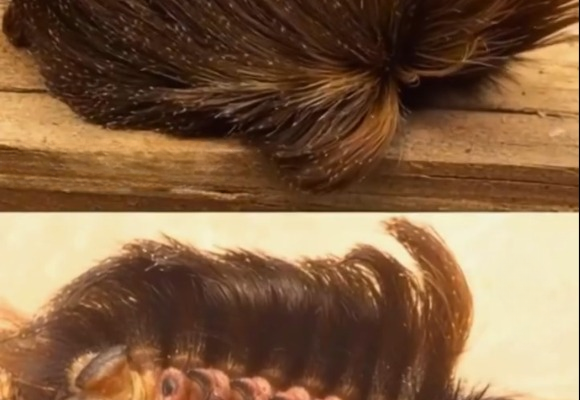
Don’t Be Fooled: This ‘Cute’ Fuzzy Insect in Your Yard Could Be Dangerous
In the digital age, one of the most remarkable benefits of social media is its ability to spread critical information at lightning speed. Whether it’s news, health tips, or alerts about potential hazards, information can now reach thousands—or even millions—of people almost instantly. Sometimes, this rapid sharing can be lifesaving. Such was the case for a Florida family when a routine afternoon of yard work turned into a frightening medical emergency, all triggered by a seemingly adorable and harmless insect.
It began a few years ago when Andrea Pergola noticed something concerning on her 15-year-old son, Logan. He had been gathering tree branches for a volunteer project, a simple task he had done countless times before. But this day was different. A brief, sharp sting had left him with a red mark on his skin, unusual in both appearance and severity. The mark resembled a grid pattern, as if a microscopic lattice had been pressed against his arm. At first, it seemed minor, but as the redness spread and Logan complained of discomfort, Andrea knew she had to act quickly.
The Initial Sting
Logan had been working with fallen branches in the yard when something brushed against him. He felt a momentary sting, akin to a sharp pinch, but brushed it off as insignificant. He continued with his volunteer task, unaware of the severity of what had just occurred.
Andrea, noticing the unusual mark on his skin, attempted to treat it at home with standard remedies—washing the area and applying over-the-counter antihistamines. However, nothing seemed to alleviate the discomfort, and the red mark persisted, growing more pronounced with time. Concerned, Andrea examined the scene more closely, searching for any signs of what might have caused the injury.
It was Logan’s grandfather who discovered the culprit: a small, fuzzy caterpillar resting on the branches he had been collecting. To the untrained eye, the insect appeared harmless, almost “cute” in its appearance. Its soft, hairy exterior was deceptively innocent-looking, but Andrea and her family were about to learn just how dangerous it could be.
Identifying the Threat
Once the caterpillar was safely contained in a bag using heavy gloves, Andrea began researching online. What she discovered was alarming. The creature was identified as one of North America’s most toxic caterpillars, capable of causing severe reactions if touched. These insects are not aggressive by nature, but a casual encounter—like brushing against one while doing yard work—can deliver a painful and potentially dangerous sting.
Andrea quickly realized that Logan’s brief encounter had exposed him to a serious medical risk. The home remedies she had tried were insufficient, and she needed professional medical attention immediately. The family rushed Logan to the emergency room, where he could receive proper treatment.
A Mother’s Warning Goes Viral
Once the ordeal was over, Andrea felt compelled to share her experience with the public. She turned to Facebook, posting a heartfelt warning about the dangers of the caterpillar. Her message was clear: research the insect, teach your children to recognize it, and seek immediate medical attention if stung.
“It is not native to Florida, but originally from Texas. It just happens to live here now. Please, if you or your child is stung, go to the ER. Over-the-counter remedies like Benadryl will not suffice. We didn’t realize he had been stung multiple times, and home treatments wouldn’t have worked,” she wrote.
Andrea’s post quickly gained attention, resonating with parents, gardeners, and outdoor enthusiasts alike. The story served as a reminder that nature, even in its seemingly innocuous forms, can be unexpectedly dangerous.
Why the Caterpillar Is So Dangerous
The caterpillar in question belongs to a class of insects that may appear soft, colorful, and entirely harmless, yet carry toxic spines capable of delivering venom. When touched, these spines can inject toxins into the skin, causing a range of reactions—from mild irritation and redness to severe pain, swelling, and systemic symptoms.
Medical experts emphasize that these reactions should never be treated casually. Even minor contact can escalate quickly, particularly in children, the elderly, or individuals with allergies. Standard antihistamines or home remedies are often insufficient, and professional medical care is crucial to prevent serious complications.
Symptoms of contact can include:
- Redness and swelling at the sting site
- Sharp, burning pain
- Rash in grid-like patterns or unusual formations
- Itching or tingling
- In severe cases, nausea, fever, or dizziness
The severity depends on the extent of contact and the individual’s sensitivity to the caterpillar’s venom.
How to Identify the Caterpillar
Identifying these caterpillars is critical for prevention. They are typically:
- Fuzzy or hairy with soft, cotton-like exteriors
- Small to medium in size, often just a few centimeters long
- Colorful, sometimes featuring bright warning colors like orange or red
- Found on trees, shrubs, or fallen branches, where they may blend in with leaves
Andrea’s experience highlights a key point: appearances can be deceiving. Even creatures that look innocent or endearing may pose a serious risk. Parents, gardeners, and outdoor enthusiasts are encouraged to teach children not to touch unknown insects, regardless of how cute they seem.
Steps to Take if Stung
Andrea’s quick response likely prevented more serious complications. Experts recommend the following steps if contact occurs:
- Remove the Caterpillar Carefully: Avoid touching it with bare hands; use gloves or a tool.
- Clean the Area: Gently wash the skin with soap and water to remove toxins.
- Avoid Home Remedies Alone: Over-the-counter creams or antihistamines may not be sufficient.
- Seek Immediate Medical Attention: ER staff can provide treatment, such as topical corticosteroids or pain management, to reduce inflammation and discomfort.
Prompt action is particularly important for children, as their smaller size and lower body weight can make reactions more severe.
The Role of Social Media in Safety
Andrea’s story also illustrates the power of social media as a safety tool. By sharing her experience online, she was able to alert a large audience, potentially preventing other incidents. Platforms like Facebook, Twitter, and Instagram allow information about new or invasive species, toxic plants, or dangerous insects to spread rapidly, increasing community awareness and safety.
The speed of these warnings is unmatched compared to traditional methods, which rely on slower channels like newspapers or local broadcasts. When families are informed quickly, preventive measures can be taken before accidents occur.
Preventive Measures
To reduce the risk of caterpillar stings, experts suggest several preventive strategies:
- Educate Children: Teach them to avoid touching unknown insects or plants.
- Wear Protective Clothing: Gloves, long sleeves, and long pants reduce skin exposure when working in yards or gardens.
- Inspect Outdoor Areas: Check branches, shrubs, and fallen leaves for signs of caterpillars.
- Avoid Relocating Unknown Insects: Moving them without proper knowledge can increase the risk of stings.
Andrea emphasized that awareness is the first line of defense. Her son’s ordeal could have been far worse without timely intervention.
The Broader Implications
The caterpillar Andrea encountered is not native to Florida, originally hailing from Texas. Its presence in new areas highlights broader ecological concerns: invasive species can spread quickly, sometimes bringing new hazards to communities unprepared for them.
Experts stress that families and local authorities should remain vigilant, monitoring for unfamiliar insects or plants. Public education campaigns, social media alerts, and community workshops can all play a role in minimizing risks and ensuring public safety.
Lessons from Andrea’s Experience
Andrea Pergola’s story is a cautionary tale with several important lessons:
- Never Underestimate Nature: Even the cutest insects can be dangerous.
- Immediate Medical Attention Matters: Home remedies alone may be insufficient.
- Social Media Can Save Lives: Sharing information about hazards quickly reaches a wider audience.
- Education Prevents Accidents: Teaching children and families about risks is crucial.
- Awareness is Key in Changing Ecosystems: Invasive species can introduce unexpected dangers in new regions.
Her advocacy has sparked conversations among parents, teachers, and outdoor enthusiasts about the need for vigilance and proactive safety measures.
Logan’s Recovery and Reflection
Thanks to timely medical intervention, Logan recovered fully from the sting. The red marks on his skin faded, leaving no lasting physical effects, but the experience left a lasting impression on him and his family.
Andrea has since become a strong advocate for insect safety education, emphasizing that vigilance, proper precautions, and prompt medical attention can prevent minor incidents from turning into serious emergencies.
“I never imagined a caterpillar could put my child in the ER,” Andrea said. “It was a frightening experience, but sharing our story can help others avoid the same mistake.”
Conclusion
The story of Andrea Pergola and her son Logan underscores an important truth: danger can lurk in the most unsuspecting places. What appears cute and harmless may conceal serious risks, and awareness is often the difference between a minor incident and a medical emergency.
From social media alerts to timely ER visits, Andrea’s experience demonstrates the value of vigilance, education, and rapid response. By taking proactive measures—teaching children, wearing protective clothing, and knowing the signs of toxic exposure—families can enjoy outdoor activities safely.
The fuzzy caterpillar that caused Logan’s emergency serves as a reminder that nature deserves respect, and that even the smallest creatures can have significant consequences. With awareness, preparation, and prompt action, these dangers can be managed, keeping families safe while allowing children to explore and enjoy the world around them.
Andrea’s warning remains simple but powerful: never underestimate a “cute” insect. Know what it is, understand the risks, and act immediately if contact occurs. In this case, awareness wasn’t just helpful—it was lifesaving.


